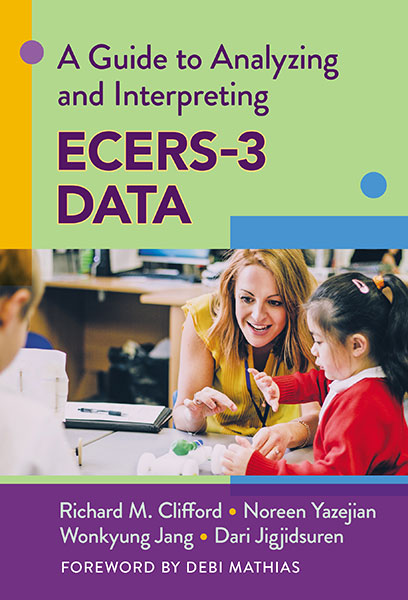
A Guide to Analyzing and Interpreting ECERS-3 Data
Richard M. Clifford, Noreen Yazejian, Wonkyung Jang, and Dari Jigjidsuren
Foreword By: Debi Mathias
Publication Date: November 16, 2021
Pages: 128
Early childhood is a crucial stage in a child’s life, and aspects of the environment in the physical, social-emotional, cognitive, and health and safety domains all play important roles in shaping children’s development. Having a reliable measure of the quality of these aspects of children’s early learning settings is critical. The Early Childhood Environment Rating Scale®, Third Edition, (ECERS-3) is a leading research-based instrument for examining these influential global factors that directly impact children in preK–K classrooms.
In this webinar for preK-K administrators, program directors, school principals, coaches, researchers, state QIS personnel, and others who use the ECERS-3, authors Richard M. Clifford, Noreen Yazejian, Wonkyung Jang, and Dari Jigjidsuren will describe how to get the most out of your ECERS-3 findings. Their new book, A Guide to Analyzing and Interpreting ECERS-3 Data provides the conceptual model underlying the ECERS-3 and ways of analyzing data for a fuller understanding of the scale and why it is integral to the evaluation of early care and education.
The session will begin with a brief overview of the principles used in developing the ECERS—what is meant by “environment,” views of how children learn, and the development of the ERS instruments—followed by a review of what the ECERS-3 looks like, the process for scoring it, and the breadth of the assessment process. The authors will present a review of descriptive statistics of early childhood programs based on data from more than 1,000 preschool classrooms in a 3-state study of the reliability and validity of ECERS-3 with a discussion of how this type of data can help providers, programs, administrators, and policymakers. The presentation will conclude with a discussion of special issues in understanding assessment process and data, and review of implications of these issues for training, public policy, and resource allocation.
